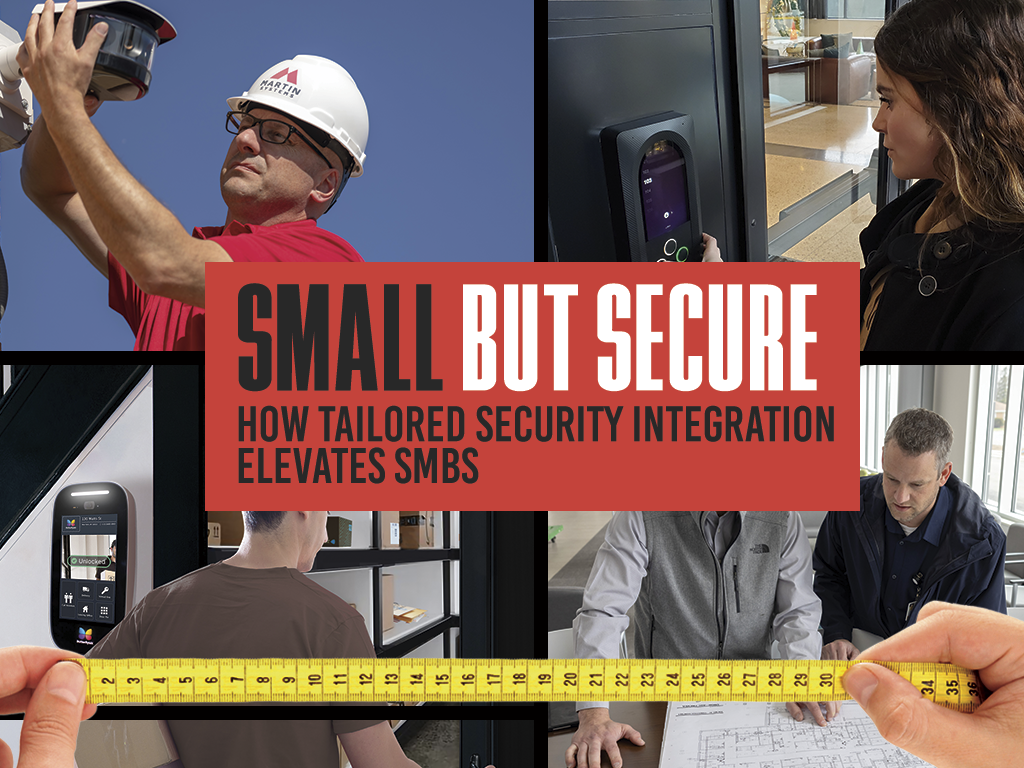Small But Secure: How Tailored Security Integration Elevates SMBs

In today’s security landscape where risks and vulnerabilities loom large, every organization, regardless of its size, needs to have security solution defenses in place. While that may not be a monetary concern for large enterprises, the budgetary burden for small to medium sized businesses (SMBs) can be a heavy one.
The good news is that integrated security solutions can be tailored to address the specific security pain points that SMBs face. All while being implemented at a manageable price point. Here Cory Peters, President and owner of Green Bay, Wisconsin-based Martin Systems Inc., shares some keen insights on how this can be achieved. Since 1974, Martin Systems has helped people be better prepared and protected with the most modern technology in security, fire, and life safety.
ADDRESSING SMBS CHALLENGES HEAD ON
The primary challenge for SMBs, Peters says, is finding a partner who understands their unique needs and can guide them in wisely investing their security budget. “Often, businesses encounter missteps with their initial choices due to vendors focusing more on selling products than providing tailored solutions. Effective security not only protects against threats but also enhances money management, reduces internal theft, and improves employee oversight, offering a significant return on investment by addressing staffing and growth challenges.”
He adds that, because SMBs aim for operational efficiency, the approach should be meeting their needs with competitive, innovative solutions. Using cloud managed systems, for example, has dramatically reduced staffing needs for SMBs. If their integration partner can provide cyber security and co-manage these systems with them, it eliminates the need for them to have their own in-house IT experts solely for security purposes, he says. This translates to lower maintenance costs and helps build value as a true partner to the customer.
DON’T TAKE RISKS – GET A RISK ASSESSMENT
Risk assessment and analysis are integral to developing customized security strategies for SMBs. Peters concurs, stating that risk assessment plays a pivotal role in uncovering and documenting the core security issues for a customer. A comprehensive understanding of the security landscape can be ensured, he contends, by conducting a thorough and methodical assessment that includes defining clear and concise security goals and objectives; identifying and cataloging critical assets; analyzing potential threats and vulnerabilities; and estimating the impact of these threats on the business.
His reasoning is that this meticulous approach not only aligns the integrator and the customer with the immediate priorities, but it also allows them to pinpoint targeted, effective security measures together. “It paves the way for a strategic partnership focused on minimizing risks and safeguarding the customer’s operations, assets, and reputation. By working towards a common vision of success, risk assessments both chart a clear path toward successful system deployment and facilitate a proactive security posture, thereby optimizing resource allocation and enhancing overall resilience against emerging threats,” he notes.
INTEGRATING DISPARATE SYSTEMS DELIVERS MORE THAN THE SUM OF ITS PARTS
There’s a reason why so many enterprises are opting to integrate various security technologies, such as access control systems, video surveillance, intrusion detection, and cybersecurity measures into a cohesive and efficient security infrastructure. As Peters explains, “Integrating diverse security technologies into a unified infrastructure significantly bolsters an organization’s defense mechanisms by creating a multi-layered security posture, especially where Security Operation Centers (SOCs) might be involved. This approach enhances situational awareness through the real-time consolidation of data and alerts, ensuring a swift and coordinated incident response. Moreover, such integration proves to be cost-effective by streamlining operations and reducing the overhead of managing disparate systems. It also offers scalability and flexibility, essential for redundancies to an SOC and adapting to evolving security needs and ensuring regulatory compliance. Importantly, the aggregation of data across systems enhances decision-making with actionable insights and improves user experience by facilitating smoother access processes. The goal is to enhance the user experience by making access as seamless and hassle-free as possible, without compromising security protocols.”
He does add, however, that given the growing complexity of these technologies, partnering with a professional security vendor capable of co-managing these various systems is indispensable. That’s because a skilled vendor ensures that the security infrastructure not only remains robust against emerging threats but also remains aligned with the organization’s changing requirements, guaranteeing long-term resilience and operational efficiency.
The need to implement security solutions that are flexible and scalable has become quite clear over recent years. As security threats and vulnerabilities continue to evolve, it’s top of mind for organizations to allow for protections that may be warranted well into the future. This is not only a budgetary consideration, but a wise decision to make in maximizing the capabilities of their security solutions and ensuring an ongoing integrator – customer relationship.
As Peters echoes, flexible systems are key to growing and supporting an SMB customer. Their needs change over the years, and working with them as a consultant, growing and evolving with them, is key to retaining a customer for life.
A CLOUD OF UNCERTAINTY HAS BEEN LIFTED
As doubts about cloud-based security have been debunked, the industry has seen an unprecedented migration to cloud-based security solutions in recent years. Peters views them as highly suitable solutions for businesses of this scale because these systems offer significant savings on software, hardware, and personnel costs. “While cloud storage for video surveillance has posed challenges due to bandwidth and internet limitations in our area, we’ve concentrated on on-premises storage solutions combined with cloud-hosted portals. This approach simplifies management and enables secure access from any web-enabled device, delivering immense value to our customers. Consequently, it has significantly enhanced the perceived value of our partnership.”
SECURITY SOLUTIONS SUITED TO SMBs
So, which cost-effective security measures and technologies are typically suitable for SMBs? “There are many cost-effective technologies and measures that are suitable for SMBs these days, but probably the one we emphasize the most is a term we call Co-Managed systems,” Peters says. “Co-Managed allows the end user full control and management, but with the backup, support, and consultative expertise of a security provider. It’s a true partnership that should be fostered, one that allows them ease of mind knowing they don’t have to be experts at everything so they can focus more on what makes their own business successful.”
Small to medium-sized businesses today face many challenges in today’s economic climate, particularly post-pandemic. Contending with the myriad security threats they are vulnerable to need not be one of them if they partner with a trusted security systems integrator that can take that burden off of them. By attentively looking at, assessing, and addressing those challenges with tailored security solutions, systems integrators can assist small to medium sized businesses prosper, safely and securely.




